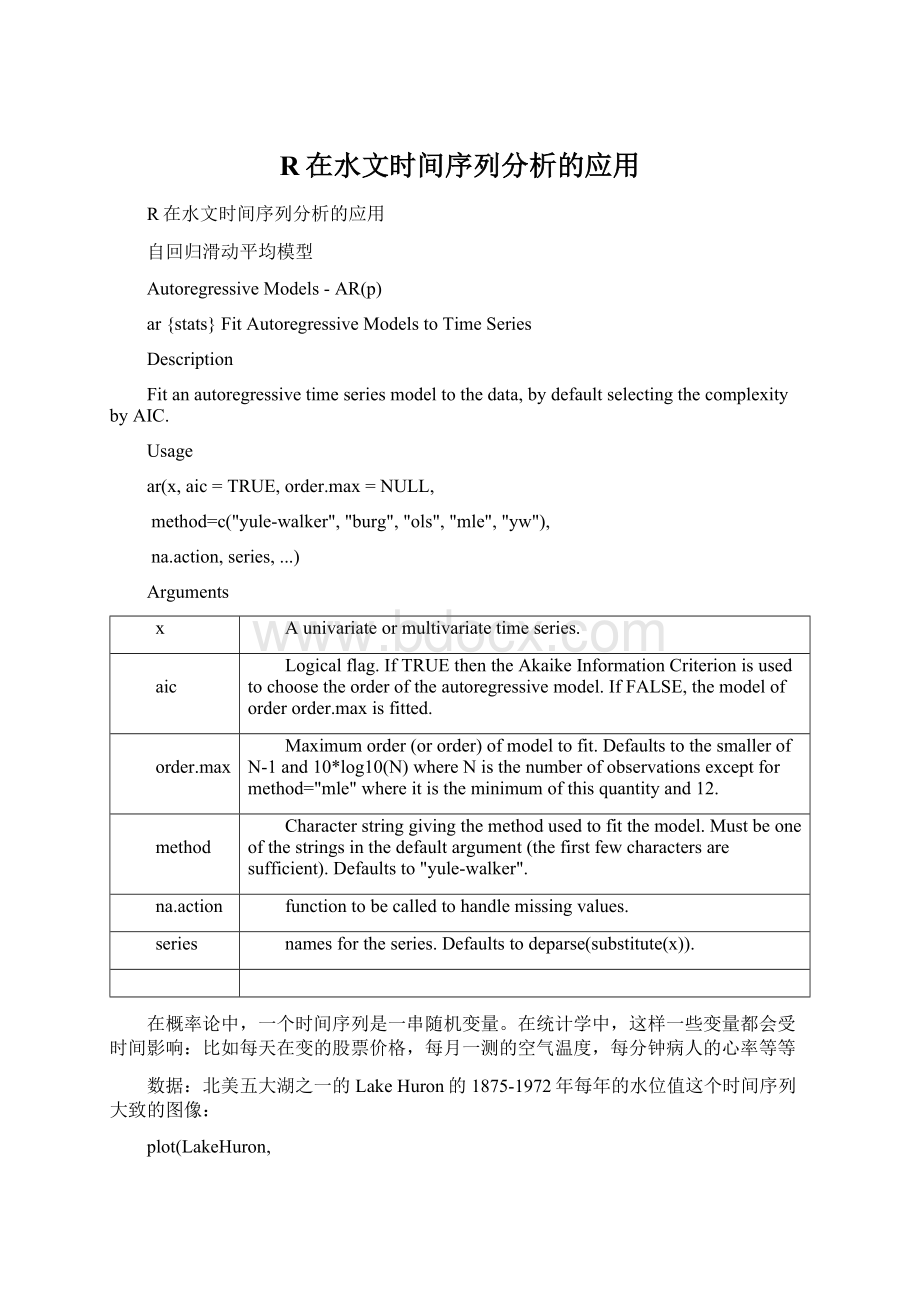R在水文时间序列分析的应用.docx
《R在水文时间序列分析的应用.docx》由会员分享,可在线阅读,更多相关《R在水文时间序列分析的应用.docx(14页珍藏版)》请在冰豆网上搜索。

R在水文时间序列分析的应用
R在水文时间序列分析的应用
自回归滑动平均模型
AutoregressiveModels-AR(p)
ar{stats}FitAutoregressiveModelstoTimeSeries
Description
Fitanautoregressivetimeseriesmodeltothedata,bydefaultselectingthecomplexitybyAIC.
Usage
ar(x,aic=TRUE,order.max=NULL,
method=c("yule-walker","burg","ols","mle","yw"),
na.action,series,...)
Arguments
x
Aunivariateormultivariatetimeseries.
aic
Logicalflag.IfTRUEthentheAkaikeInformationCriterionisusedtochoosetheorderoftheautoregressivemodel.IfFALSE,themodeloforderorder.maxisfitted.
order.max
Maximumorder(ororder)ofmodeltofit.DefaultstothesmallerofN-1and10*log10(N)whereNisthenumberofobservationsexceptformethod="mle"whereitistheminimumofthisquantityand12.
method
Characterstringgivingthemethodusedtofitthemodel.Mustbeoneofthestringsinthedefaultargument(thefirstfewcharactersaresufficient).Defaultsto"yule-walker".
na.action
functiontobecalledtohandlemissingvalues.
series
namesfortheseries.Defaultstodeparse(substitute(x)).
在概率论中,一个时间序列是一串随机变量。
在统计学中,这样一些变量都会受时间影响:
比如每天在变的股票价格,每月一测的空气温度,每分钟病人的心率等等
数据:
北美五大湖之一的LakeHuron的1875-1972年每年的水位值这个时间序列大致的图像:
plot(LakeHuron,
ylab="",
main="LevelofLakeHuron")
AR
(1)模型:
x<-LakeHuron
op<-par(mfrow=c(2,1))
y<-filter(x,.8,method="recursive")
plot(y,main="AR
(1)",ylab="")
acf(
y,
main=paste(
"p=",
signif(dwtest(y~1)$p.value,3)
)
)
par(op)
ACF和PCF图
op<-par(mfrow=c(3,1),
mar=c(2,4,1,2)+.1)
acf(x,xlab="")
pacf(x,xlab="")
spectrum(x,xlab="",main="")
par(op)
AR(p)模型使用Yule-walker法得出估计的参数值
y<-ar(x,aic=TRUE,method="yule-walker")
regr=ar.ols(x,order=2,demean=FALSE,intercept=FALSE)
regr
结果:
Call:
ar.ols(x=x,order.max=2,demean=FALSE,intercept=FALSE)
Coefficients:
12
1.1319-0.1319
Orderselected2sigma^2estimatedas0.5281
预测1973值
>1.1319*x[98]-0.1319*x[97]
[1]579.9692
参考书目:
IntroductoryTimeSerieswithR,AnalysisofTimeSeriesDataUsingR,TimeSeriesAnalysisandItsApplications--withRexamples,TimeSeriesAnalysisandItsApplications--withRexamples
参考网站:
http:
//zoonek2.free.fr/UNIX/48_R/15.html#2
MA(MovingAveragemodels)
Hereisasimplewayofbuildingatimeseriesfromawhitenoise:
justperformaMovingAverage(MA)ofthisnoise.
n<-200
x<-rnorm(n)
y<-(x[2:
n]+x[2:
n-1])/2
op<-par(mfrow=c(3,1),mar=c(2,4,2,2)+.1)
plot(ts(x),xlab="",ylab="whitenoise")
plot(ts(y),xlab="",ylab="MA
(1)")
acf(y,main="")
par(op)
n<-200
x<-rnorm(n)
y<-(x[1:
(n-3)]+x[2:
(n-2)]+x[3:
(n-1)]+x[4:
n])/4
op<-par(mfrow=c(3,1),mar=c(2,4,2,2)+.1)
plot(ts(x),xlab="",ylab="whitenoise")
plot(ts(y),xlab="",ylab="MA(3)")
acf(y,main="")
par(op)
Youcanalsocomputethemovingaveragewithdifferentcoefficients.
n<-200
x<-rnorm(n)
y<-x[2:
n]-x[1:
(n-1)]
op<-par(mfrow=c(3,1),mar=c(2,4,2,2)+.1)
plot(ts(x),xlab="",ylab="whitenoise")
plot(ts(y),xlab="",ylab="momentum
(1)")
acf(y,main="")
par(op)
n<-200
x<-rnorm(n)
y<-x[3:
n]-2*x[2:
(n-1)]+x[1:
(n-2)]
op<-par(mfrow=c(3,1),mar=c(2,4,2,2)+.1)
plot(ts(x),xlab="",ylab="whitenoise")
plot(ts(y),xlab="",ylab="Momentum
(2)")
acf(y,main="")
par(op)
Insteadofcomputingthemovingaveragebyhand,youcanusethe"filter"function.
n<-200
x<-rnorm(n)
y<-filter(x,c(1,-2,1))
op<-par(mfrow=c(3,1),mar=c(2,4,2,2)+.1)
plot(ts(x),xlab="",ylab="Whitenoise")
plot(ts(y),xlab="",ylab="Momentum
(2)")
acf(y,na.action=na.pass,main="")
par(op)
TODO:
the"side=1"argument.
AR(Auto-Regressivemodels)
Anothermeansofbuildingatimeseriesistocomputeeachtermbyaddingnoisetotheprecedingterm:
thisiscalledarandomwalk.
Forinstance,
n<-200
x<-rep(0,n)
for(iin2:
n){
x[i]<-x[i-1]+rnorm
(1)
}
Thiscanbewritten,moresimply,withthe"cumsum"function.
n<-200
x<-rnorm(n)
y<-cumsum(x)
op<-par(mfrow=c(3,1),mar=c(2,4,2,2)+.1)
plot(ts(x),xlab="",ylab="")
plot(ts(y),xlab="",ylab="AR
(1)")
acf(y,main="")
par(op)
Moregenerally,onecanconsider
X(n+1)=aX(n)+noise.
Thisiscalledanauto-regressivemodel,orAR
(1),becauseonecanestimatethecoefficientsbyperformingaregressionofxagainstlag(x,1).
n<-200
a<-.7
x<-rep(0,n)
for(iin2:
n){
x[i]<-a*x[i-1]+rnorm
(1)
}
y<-x[-1]
x<-x[-n]
r<-lm(y~x-1)
plot(y~x)
abline(r,col='red')
abline(0,.7,lty=2)
Moregenerally,anAR(q)processisaprocessinwhicheachtermisalinearcombinationoftheqprecedingtermsandawhitenoise(withfixedcoefficients).
n<-200
x<-rep(0,n)
for(iin4:
n){
x[i]<-.3*x[i-1]-.7*x[i-2]+.5*x[i-3]+rnorm
(1)
}
op<-par(mfrow=c(3,1),mar=c(2,4,2,2)+.1)
plot(ts(x),xlab="",ylab="AR(3)")
acf(x,main="",xlab="")
pacf(x,main="",xlab="")
par(op)
Youcanalsosimulatethosemodelswiththe"arima.sim"function.
n<-200
x<-arima.sim(list(ar=c(.3,-.7,.5)),n)
op<-par(mfrow=c(3,1),mar=c(2,4,2,2)+.1)
plot(ts(x),xlab="",ylab="AR(3)")
acf(x,xlab="",main="")
pacf(x,xlab="",main="")
par(op)
PACF
ThepartialAutoCorrelationFunction(PACF)providesanestimationofthecoefficientsofanAR(infinity)model:
wehavealreadyseenitonthepreviousexamples.Itcanbeeasilycomputedfromtheautocorrelationfunctionwiththe"Yule-Walker"equations.
Yule-WalkerEquations
Tocomputetheauto-correlationfunctionofanAR(p)processwhosecoefficientsareknown,
(1-a1B-a2B^2-...-apB^p)Y=Z
wejusthavetocomputethefirstautocorrelationsr1,r2,...,rp,andthenusetheYule-Walkerequations:
r(j)=a1r(j-1)+a2r(j-2)+...+apr(j-p).
YoucanalsousethemintheotherdirectiontocomputethecoefficientsofanARprocessfromitsautocorrelations.
Description
FitanARMAmodeltoaunivariatetimeseriesbyconditionalleastsquares.Forexactmaximumlikelihoodestimationsee arima0.
Usage
arma(x,order=c(1,1),lag=NULL,coef=NULL,
include.intercept=TRUE,series=NULL,qr.tol=1e-07,...)
Arguments
x
anumericvectorortimeseries.
order
atwodimensionalintegervectorgivingtheordersofthemodeltofit. order[1] correspondstotheARpartand order[2] totheMApart.
lag
alistwithcomponents ar and ma.Eachcomponentisanintegervector,specifyingtheARandMAlagsthatareincludedinthemodel.Ifboth, order andlag,aregiven,onlythespecificationfrom lag isused.
coef
IfgiventhisnumericvectorisusedastheinitialestimateoftheARMAcoefficients.ThepreliminaryestimatorsuggestedinHannanandRissanen(1982)isusedforthedefaultinitialization.
include.intercept
Shouldthemodelcontainanintercept?
series
namefortheseries.Defaultsto deparse(substitute(x)).
qr.tol
the tol argumentfor qr whencomputingtheasymptoticstandarderrorsof coef.
Examples
data(tcm)
r<-diff(tcm10y)
summary(r.arma<-arma(r,order=c(1,0)))
summary(r.arma<-arma(r,order=c(2,0)))
summary(r.arma<-arma(r,order=c(0,1)))
summary(r.arma<-arma(r,order=c(0,2)))
summary(r.arma<-arma(r,order=c(1,1)))
plot(r.arma)
data(nino)
s<-nino3.4
summary(s.arma<-arma(s,order=c(20,0)))
summary(s.arma
<-arma(s,lag=list(ar=c(1,3,7,10,12,13,16,17,19),ma=NULL)))
acf(residuals(s.arma),na.action=na.remove)
pacf(residuals(s.arma),na.action=na.remove)
summary(s.arma
<-arma(s,lag=list(ar=c(1,3,7,10,12,13,16,17,19),ma=12)))
summary(s.arma
<-arma(s,lag=list(ar=c(1,3,7,10,12,13,16,17),ma=12)))
plot(s.arma)
(本资料素材和资料部分来自网络,仅供参考。
请预览后才下载,期待您的好评与关注!
)